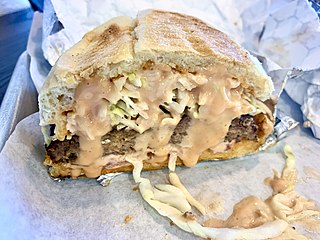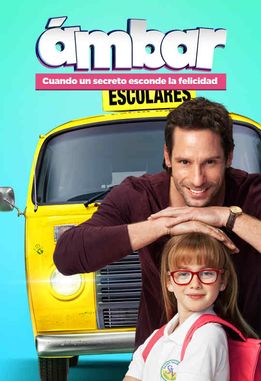
An enchilada is a Mexican dish consisting of a corn tortilla rolled around a filling and covered with a savory sauce. Enchiladas can be filled with various ingredients, including meats, cheese, beans, potatoes, vegetables, or combinations. Enchilada sauces include chili-based sauces, such as salsa roja, various moles, tomatillo-based sauces, such as salsa verde, or cheese-based sauces, such as chile con queso.

Puerto Rican cuisine consists of the cooking style and traditional dishes original to Puerto Rico. It has been primarily influenced by the ancestors of the Puerto Rican people: the indigenous Taínos, Spanish colonizers, and sub-Saharan African slaves. As a territory of the United States, the culinary scene of Puerto Rico has also been moderately influenced by American cuisine.

A churro is a type of fried dough from Spanish and Portuguese cuisine, made with choux pastry dough piped into hot oil with a piping bag and large closed star tip or similar shape. They are also found in Latin American cuisine, Philippine cuisine, and in other areas that have received immigration from Spanish and Portuguese-speaking countries, especially in the Southwestern United States and France.

Cuban cuisine is largely based on Spanish cuisine with influence from Taino, African and other Caribbean cuisines. Some Cuban recipes share spices and techniques with Spanish, Taino and African cooking, with some Caribbean influence in spice and flavor. This results in a blend of several different cultural influences. A small but noteworthy Chinese influence can also be accounted for, mainly in the Havana area. There is also some Italian influence. During colonial times, Cuba was an important port for trade, and the Spanish ancestors of Cubans brought with them the culinary traditions of different parts of Spain.

An alfajor or alajú is a traditional confection typically made of flour, honey, and nuts. It is found in Argentina, Bolivia, Paraguay, the Philippines, Southern Brazil, Southern France, Spain, Uruguay, Peru, Ecuador, Colombia and Chile. The archetypal alfajor entered Iberia during the period of al-Andalus. It is produced in the form of a small cylinder and is sold either individually or in boxes containing several pieces.

Creole cuisine is a cuisine style born in colonial times, from the fusion between European, African and pre-Columbian American traditions. Creole is a term that refers to those of European origin who were born in the New World and have adapted to it.

Panela or rapadura is an unrefined whole cane sugar, typical of Latin America. It is a solid form of sucrose derived from the boiling and evaporation of sugarcane juice. Panela is known by other names in Latin America, such as chancaca in Chile, Bolivia, and Peru, piloncillo in Mexico. Just like brown sugar, two varieties of piloncillo are available; one is lighter (blanco) and one darker (oscuro). Unrefined, it is commonly used in Mexico, where it has been around for at least 500 years. Made from crushed sugar cane, the juice is collected, boiled, and poured into molds, where it hardens into blocks. It is similar to jaggery, which is used in South Asia. Both are considered non-centrifugal cane sugars.

Dulce María Espinosa Saviñón, simply known as Dulce María, is a Mexican actress, songwriter, singer and author.

Pan de muerto is a type of pan dulce traditionally baked in Mexico and the Mexican diaspora during the weeks leading up to the Día de los Muertos, which is celebrated from November 1 to November 2.

Dominican cuisine is made up of Spanish, indigenous Taíno, Middle Eastern, African, Cuban, Puerto Rican and Haitian influences. The most recent influences in Dominican cuisine are from the British West Indies and China.

Muy padres is a Mexican telenovela produced by Agustín Restrepo and Aurelio Valcárcel Carroll for Imagen Televisión that premiered on September 18, 2017. This is the fourth original production of Imagen Televisión and bringing with it new talents. It is an adaptation of the Argentine story written by Marcela Guerty and Pamela Rementería titled Señores Papis. The telenovela revolves around three dads and the relationship problems between parents and children, as well as situations of single parents who care for their children, besides addressing topics such as alcoholism, child sexual abuse and children with Down syndrome.
Jasmine and Melissa Hemsley are English food writers and media personalities who have been closely associated with the clean eating and "wellness" movement. Their first book, The Art of Eating Well (2014) spawned a television series on Britain's Channel 4 titled Eating Well with Hemsley + Hemsley.
Michelle Posada is a Venezuelan actress and restaurateur. She is portrayed the character of "Estela" in nine episodes of the telenovela "Bajo el mismo cielo" which aired in the United States on the Telemundo Network from 2015-16. She has also appeared in "Las Caras del Diablo 2" (2014), "El Psiquiatra" (2014), "Escandalos: Todo es real excepto sus nombres" (2015), "La Banda" (2011) and "Ruta 35" (2016).

Ámbar is a Chilean telenovela created by Daniella Castagno, that premiered on Mega on August 22, 2016 and ended on April 10, 2017. It stars Giulia Inostroza, Sigrid Alegría, Gonzalo Valenzuela and Álvaro Morales.

Macarena Olona Choclán is a Spanish politician and state attorney, member of the Congress of Deputies between 2019 and 2022 for Vox, before being allegedly involved in an internal feud that led to her expulsion from the party.

Xnipec is a spicy sauce native to the Yucatán peninsula, made with habanero pepper, purple onion, bitter orange juice and salt. Sometimes oregano, vinegar, bay leaf, coriander or pepper are also used. If sweet orange is used, lemon juice can be added to acidify it; if sour orange is used, it is not necessary.

Marisela del Carmen Santibáñez Novoa is a Chilean actress, presenter, and politician of the Communist Party (PCCh). She has been a member of the Chamber of Deputies for District 14 since March 2018.

Johana Clavel is a Venezuelan cook, entrepreneur and television personality, that has been featured and several television programs in the Telemundo, ¡Hola! TV and the Univisión networks. She also founded the Ligero Express restaurant chain with premises in her home country Venezuela and in the United States. In 2019 she published the book Cocina latina ligera through Penguin Random House.
María Bernarda Seitz, better known as La Hermana Bernarda, was an Argentine Roman Catholic nun, writer, chef, and television presenter.















